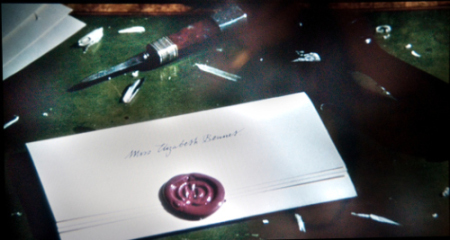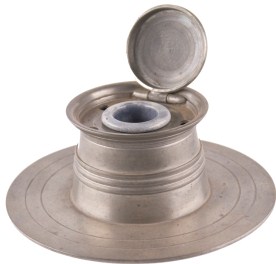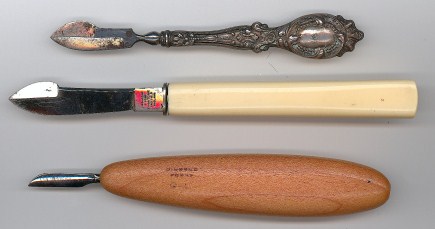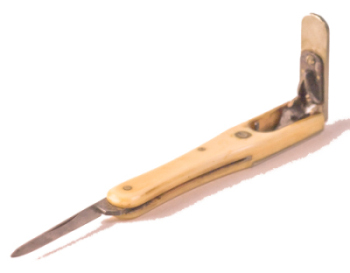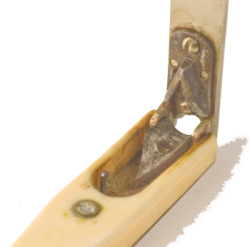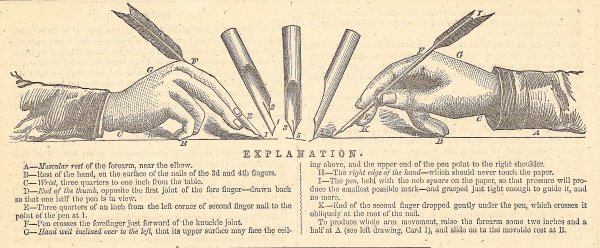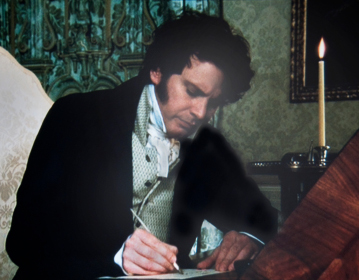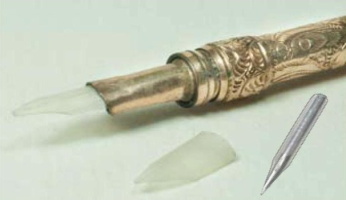|
Jane Austen’s aficionados will know the scene. The proposal of marriage by Fitzwilliam Darcy, played by Colin Firth, has been unceremoniously shot down by Jennifer Ehle’s Elizabeth Bennet. Darcy quick marches back to his room at Rosings and with pen in hand proceeds to write one of the most famous letters in English literature. For a penmanship historian, the letter writing scene in this 1995 adaptation causes more than a little seat-squirming.
With the candle extinguished, the letter finished and sealed, the camera pans downward to the writing table. There the quill knife is surrounded by shards of quill points past. The scene is supposed to show the arduous effort Darcy has put into the letter. Presumably, he has stopped more than once to re-cut his pen.
Stop to re-cut his pen? No way. Though Darcy’s letter writing scene has more than a few historical peculiarities from a penmanship standpoint, it is a great launching point for a discussion of handwriting in Jane Austen’s era.
The mechanics of handwriting
Handwriting was hard work, but it was work engaged willingly because the letter was the principal form of nonverbal communication. Essential to all handwriting of course were ink, paper and pen.
In Jane Austen’s time, the feather quill and the pencil were the main writing instruments of choice. The graphite pencil, similar to what we know today, has been available since the 1500s, but it was the quill that was most favored. Since during the course of writing, a pen gradually absorbs ink, softens, and has to be replaced, a writer would have had several sharpened quills on hand ready to go. Wipe the old quill, set it down, pick up a new one, and continue. As the first quill dries, it reconstitutes, hardens, and is ready to use again. Generally, one could get a week’s worth of work out of a quill before it wore out. Rarely was a quill re-cut; they weren’t that expensive. In any case, a soft, wet quill couldn’t be cut; it would tear.
Would Darcy have prepared his own quills? Not likely. Not many people cut their own pens, for turning a feather into a pen was a time-consuming specialized skill requiring much patience and the ability to accept the fact that a few will be ruined in the cutting. Darcy had more important work to do, like managing his business affairs. Prepared quills could be purchased in quantity from an apothecary, stationer, or general store. There was a brisk feather trade in England at the time selling to companies specializing in the preparation of feathers for quills and in the actual cutting of the pen point.
Not any feather could be used: only the primary wing feathers of a large bird. All other feathers on the bird are too soft to make a good pen. Goose, turkey, and swan were highly prized, and those of a crow could be made to render very fine lines (hence the “crow quill”). Feathers were first stripped of their barbs and the natural grease coating scraped away. The feather was then hardened by heat treating in sand. A super sharp specialized quill knife formed the pen. Because of the curve of the feather, left-wing feathers are best for right-handed penmen and vice versa. While most quill knives could be used to mend a pen, most people carried a smaller “pen knife” for the task. Erasing mistakes was accomplished by scraping ink from vellum or parchment with an eraser similar to that found on the top two quill knives in the photo below. One could also scrape ink from thick paper by scraping with the grain. The thicker the paper, the better the chance of success.
As Elizabeth watches Darcy writing to his sister at Netherfield, Miss Bingley offers to assist: “‘I am afraid you do not like your pen. Let me mend it for you. I mend pens remarkably well.’” Darcy’s response—“‘Thank you—but I always mend my own’” (47)—was typical as writers generally did prefer to mend their own pens. Mending the pen should not be confused with cutting the pen. Mending the point was maintaining the point of a previously cut quill. It was easy to do, and writers used a small “pen knife” for fixing the tip. During the course of writing, a point will become dull and slightly misshaped if handled properly. A little fine tuning, and the point is as good as new. Eventually, the quill is so worn it has to be re-cut or simply thrown away.
In writing his letter to Elizabeth, Darcy might have been expected to use three, maybe four quills—not necessarily because they would have been worn, but because they would have been so soaked in ink that they would have become soft and the point too pliant to render a good line. When writing with a quill, a soft cushion under the paper is essential. It prevents the point from wearing too quickly. Jane Austen’s famous “writing box,” a folding desk that could be placed atop a table, had a felt cushion on its surface to preserve her quill’s point. Colin Firth’s Darcy, however, lays his paper on the desk without a cushion beneath it. Since the desk of Mr. Firth’s Darcy had no such felt top, his quills would likely have worn more quickly.
A modern scribe, used to pressing hard with a ballpoint or fountain pen, would find the quill a challenge requiring considerable practice. Writing with a quill demands an extremely light touch. The delicate point of the feather can’t take the pressure of a heavy hand.
If a thicker line is desired, the pen knife is used to blunt the point a bit, creating a chisel-like edge. Charles Bingley’s writing style reveals a heavy hand. His sister describes him writing “‘in the most careless way imaginable. He leaves out half his words, and blots the rest.’” Mr. Bingley admits, “‘My ideas flow so rapidly that I have not time to express them . . .’” (48). Such a scattered person is likely to write very quickly and with a heavy hand as he is so focused on the quick thought and not measuring his words. It would also explain his frequent need to blot as a heavy hand is hard on the quill, spraying ink everywhere.
In contrast, the writing posture of Colin Firth as Fitzwilliam Darcy in the 1995 production of Pride and Prejudice is excellent: his back is relatively straight, and he is not hunched over his work. His posture is what was taught in Jane Austen’s time and now. He holds his quill properly, but the hand rolls to the outside, which cants the penpoint, putting pressure on the right side and thus wearing the pen unevenly. He will have to “mend his pen” sooner. This rolling of the hand is a common problem even with penmen today, especially as one gets older. The engraving (above) from Compendium of Spencerian or Semi-Angular Penmanship shows the proper way to hold a pen: the hand and wrist are upright with the forefinger directly over top for maximum pen control. It is not a natural position and requires training and practice for proficient writing.
A third writing option available in Jane Austen’s time was the quill nib. The quill nib looked much like its descendant, the steel pen that would appear en masse in the decade following Miss Austen’s passing. Holders could be plain wood or elegant gold or silver. Quill nibs were cut as in the image below and sometimes a section of the rounded barrel was used. According to Michael Finlay in Western Writing Implements in the Age of the Quill Pen, a box of 25 quill nibs cost three shillings circa 1810-1815. By 1822, the cost had fallen to three shillings per hundred (125).
Quill nibs had been on the market more than a century before Jane Austen’s birth. They were often utilized in custom pens that reflected the continuing quest to develop a pen with its own self-contained ink system that would alleviate the need to constantly dip into the ink. While a reasonably successful design, the quill fountain pen was not inexpensive, costing more than two pounds, a considerable sum at the time.1
Ink was very easy to find. Normally, it was sold in powdered form. Add a specified amount of water, and stir to obtain the black liquid. There were two main types of writing ink available for Jane Austen, basic carbon black ink and iron gall ink. The basic carbon black ink consisted of soot or lamp black mixed with a weak gum or glue solution. Iron gall ink was most favored, especially by governments, because of its highly acidic, jet-black texture. The acidity tightly bound the ink into the paper, making it hard to erase and thus presenting a fair degree of difficulty to forgers. Iron gall ink results from gall nuts being soaked in water to release tannic and gallic acids and then mixed with an iron salt such as ferrous sulfate. Its ability to render fine hairlines makes it wonderful for writing even today. The iron in the ink, however, oxidizes—literally rusts—turning the ink brown. The rust is not good for the document and will ultimately destroy the paper.2
As easy as ink was to find, paper was precious. Nearly all of the paper during Jane Austen’s lifetime would have been 100% rag wove, made by hand, large sheet by large sheet, and cut to size. According to the British Association of Paper Historians, there were 430 paper mills in England, Scotland and Wales by the year 1800 (“History”). In that year, the mills made 11,000 tons of paper using 24 million pounds of rags. Government was by far the best customer for the mills, but there was paper left for private citizens who could afford it. Jane Austen, it would seem, had all the paper she needed to write her manuscripts and correspondence.
In Paris, 1799, Nicholas Louis Robert patented a “papermaking machine” to automate the process. Though not a successful venture for Robert, his invention came to the attention of brothers Henry and Sealy Fourdrinier and an engineer friend of theirs, Bryan Donkin in London. They made significant improvements, designing a papermaking machine that made continuous lengths of paper cut into sheets. The basics of their design are still used today. They built and operated their first paper mill in Frogmore, Hertfordshire, in 1803. Commercially, the Fourdrinier venture was not a success, and the patent for the papermaking machine fell onto the open market. The result was an explosion of paper plants in Europe and America. Paper eventually became less expensive and more available to all. Many people who as schoolchildren learned to write on slates were able to put pen to paper by the 1840s.
A problem that writers had then—just as they do now—was the compatibility of ink and paper. Occasionally, the ink will “feather” through paper fibers, ruining the letter, as if one were writing with a fountain pen on a paper towel. High quality paper utilizes a gelatinous size, mainly a hide glue, that gives the paper strength and also serves to aid the paper in properly accepting ink. Should there not be enough size, or should it not be as compatible with the ink as one would like, the application of powdered gum sandarac would be hand rubbed into the paper surface. Sandarac is sometimes referred to as “pounce.”3 Sandarac or pounce was sprinkled onto the paper with the pounce pot (sometimes called a sander or sand-dredger), which looked like a large salt shaker. Excess powder could be swept back into the pot with a brush or feather. Calligraphers still use sandarac today in an effort to obtain the finest hairline their paper-ink-pen combination can yield, but no one would want to perform this task on every sheet of paper.
The quest for good paper that needed no sandarac has always been paramount. With all of the mills in England in Jane Austen’s time, competition created very good paper—so good, in fact, that pounce was eventually replaced by a chalky substance (still called pounce) that helped ink dry more quickly.
Once a letter was finished, it still had to be delivered to the recipient. As a rule, written sheets were folded and wax sealed. Envelopes added greatly to the postage assessed by England’s postal system.
Jane Austen’s handwriting
Jane Austen’s writing style is classic English Roundhand better known today as copperplate. It was the style children in England and America were taught then, and it is still the hand most favored in England now. Austen’s handwriting is what anyone would want. The slant angle of the letters is wonderfully consistent as are the basic letterforms.4
Notes 1. For more on the steps involved in cutting a quill, the best treatise is by Donald Jackson, Calligrapher to Queen Elizabeth II and the moving force behind the St. John’s Bible. 2. Carbon black inks in various forms are available today. Sumi preparations are examples of carbon black ink and differ little over more than one thousand years. Iron gall inks are available, too, though from specialty stores (for example, http://www.paperinkarts.com/ and http://www.johnnealbooks.com). Look for McCaffery’s, Walker’s or Blott’s iron gall inks. A new iron gall ink, Old World Ink, has recently become available and may be found at www.oldworldink.com. All are excellent and are made from old formulae. For more on old inks and their formulae, see Professor Evan Lindquist’s website, which lists many inks from the past in a number of colors: http://evanlindquist.com/othermedia/oldinkrecipes.html. 3. Pounce also pertains to a pumice that was used on parchment and vellum (but not paper; pumice is too rough on the fibers) to increase its ability to receive ink. Sandarac was used on parchment and vellum as well. 4. To read more about writing in the age of Jane Austen, see Michael Finlay’s Western Writing Implements in the Age of the Quill Pen. There are also a number of old penmanship books digitized in the Rare Books section of www.iampeth.com, the website of the International Association of Master Penmen, Engrossers and Teachers of Handwriting, a resource full of penmanship history and well worth the look. Works Cited Austen, Jane. Pride and Prejudice. Ed. R. W. Chapman. 3rd ed. Oxford: OUP, 1932. Finlay, Michael. Western Writing Implements in the Age of the Quill Pen. Carlisle, UK: Plains, 1990. “History of Papermaking in the United Kingdom.” British Association of Paper Historians. 7 May 2009. 21 Sept. 2009 http://www.baph.org.uk/general%20reference/history_of_papermaking_in_the_united%20kingdom.htm Jackson, Donald. “Preparation of Quills and Reeds.” The Calligrapher’s Handbook. Ed. Heather Child. 2nd ed. New York: Taplinger, 1986. 15-38. Langton, Simon, dir. Pride and Prejudice. Perf. Jennifer Ehle, Colin Firth. BBC/A&E, 1995. |


